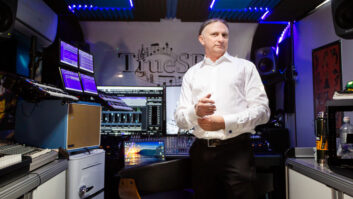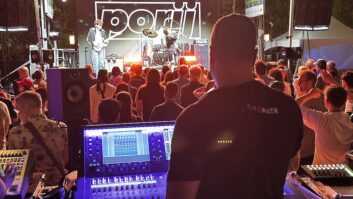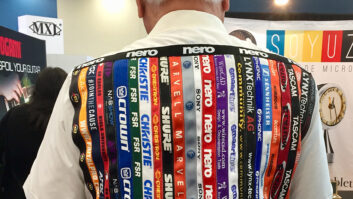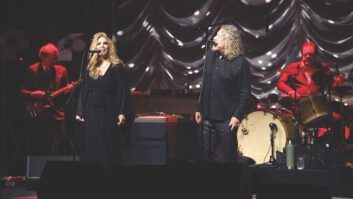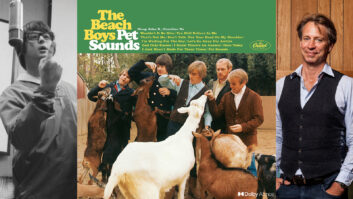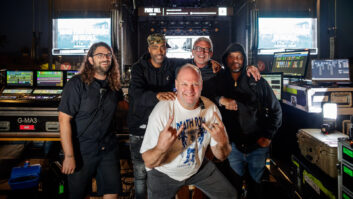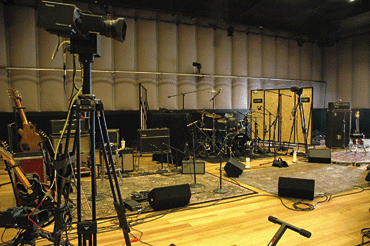
The sprawling layout of CenterStaging, Burbank, Calif.’s largest rehearsal facility, boasting 11 rehearsal studios, a massive equipment warehouse and a hangar-sized soundstage, might be mistaken for a series at outbuildings of the Burbank Airport, which is on the other side of Hollywood Way. Winona Avenue, running perpendicular to the main drag, dissects the company’s spread. On the north side are the spartan executive offices, along with five conventional rehearsal rooms, one of which was recently occupied by Guns N’ Roses, who are following on the heels of The Killers.
But it’s the setup on the south side of the street that is becoming CenterStaging’s big ticket. Each of the six newer rehearsal spaces is wired for sound and HD video so that the creative processes of willing bands and artists can be captured on the fly and edited into documentaries for airing on the company’s year-old site, rehearsals.com, and an ever-growing assortment of digital platforms. Thus far, more than 100 acts have been given this behind-the-scenes treatment, which the Website provides in exchange for the rights to use and derive revenue from the edited footage online and elsewhere.
We’re getting a guided tour from head of business development Tommy Nast, who pitches the service to the music biz people he’s interacted with during his 20 years at now-defunct music trade mag Album Network. Nast, who more recently spent two years at concert production company AEG, came to CenterStaging last year. Nast ushers us into Studio 10, a roomy 60×38 feet with 18-foot ceilings. Several cameras are mounted on sliders that are fitted on all four sides a couple of feet below the ceiling.
“Michael Bublé was here last week,” says Nast. “He’s a good example of an artist who was booked to rehearse here, and Warner Bros. and management said, ‘We want to shoot Michael rehearsing for a day so we can have footage for future use, and you have all the infrastructure and equipment to do what we want.’ This stuff is the ultimate EPK or B-roll, and content for the artist’s Website or MySpace page. It would typically cost a label 100-grand a day for the audio and visuals we’re providing.”
Nast introduces us to rehearsals.com supervising producer David Plakos, who oversaw the execution of the concept after company co-founder Johnny Caswell came up with it four-and-a-half years ago.
“Johnny provides the best facility, the best equipment and the best experience to help artists further their craft, so they trust him,” Plakos enthuses. “One day, we were on the stage at the Shrine Auditorium, and John said, ‘Y’know, I founded these studios; I should put some cameras in there.’ And I went, ‘Robotic cameras,’ and he said, ‘Yeah, fly on the wall.’ My life changed in that second. I drew it out on a napkin that day and gave it to Dave Canning, who’s our chief science officer, and Dave proceeded to build these world-class high-definition facilities.”

From left: Howard Livingston (CFO, CenterStaging), Roger Paglia (CEO, CenterStaging), Johnny Caswell (founder and chairman, CenterStaging), Felix Cavaliere, Tommy Nast (executive VP, CenterStaging)
We enter Studio 11, the largest of the spaces, which recently hosted John Mellencamp in a 12-camera shoot. A few months back, filmmaker Peter Bogdanovich used rehearsals.com’s robotically controlled Panasonic 720p HD cameras fitted with Fujinon zoom lenses and the AMX PT-30 PosiTrack pan/tilt camera controllers for full coverage of what are expected to be key scenes in the filmmaker’s feature-length documentary on Tom Petty & The Heartbreakers.
“Every camera was iso’d, and we shot for six hours,” says Plakos. “They walked out with 60 tapes, and Bogdanovich was just blown away. He said, ‘I’ve been following this guy for three months, and every time somebody walks up to him with a handheld camera, he just turns away. Petty walked in that room and, after five minutes, he forgot the cameras were there because we’re not in the room.’ We had 10 cameras in that room, all shooting close-ups wherever he turned.”
Plakos unlocks the security door that takes us into the control center, which houses five Final Cut edit bays, in which operators can control up to three cameras using a joystick, three dedicated control rooms outfitted with Panasonic DVCPRO HD machines and an Apple-based secure area network with 155 terabytes of storage. “There are no lines going in and out,” says Plakos. “The content lives here. These are our jewels, and we safeguard them.”
In one of the control rooms, they show us a promo piece created to hook prospective clients. The ultra-crisp, hi-def images on the 65-inch plasma display are matched in quality by the sound, even through the Harmon/Kardon Soundsticks II computer speakers. “As much as this is a hi-def video facility, artists care about what they sound like,” says Plakos. “The experience the end-user has of their music is why they’re in it, so that’s one of our priorities.”
Audio mixes are primarily done on-site, with selected outside mixers handling the overflow. The company recently started mixing in 5.1 surround and stereo to be delivered in Dolby Pro Logic for new destinations, including movie theaters. “Every instrument, amp and vocalist is miked during the performance,” rehearsals.com audio supervisor Eric White explains later. “We attach Sennheiser lavalier mics to every bandmember, and we hang up to 24 custom-modified Shure MX-202 condenser microphones from the lighting grids to capture dialog and room ambience.”

Inside one of the Final Cut–based edit bays
All mics and Dis are fed into two 56-channel racks of Yamaha AD8HRs; these are remotely controlled by head of broadcast audio Brent Dannen from a pair of Yamaha DM1000 consoles. The mic pre’s have AES outputs, which get converted to MADI streams through Euphonix FC726s. The signals are then split and sent to the DM1000s and to the multitrack audio recording stations. Recording is done with custom-built PC Audio Labs computers running Steinberg Nuendo 3.2 to SATA RAIDs installed on the PCs. “Since we can’t stop the action until the band wants to take a break,” Wright points out, “one PC serves as a master record and the other as a safety. Once the shoot is over, we convert the Nuendo projects to AAF files and then mix them in Pro Tools.” Plug-ins include McDSP, Sound Toys, URS, Sony Oxford, George Massenburg EQ, Bomb Factory, Line 6, Joe Meek, Blue Tubes, Trillium Labs TL Space, Drumagog and various Waves gear, including the Maxx BCL for mastering.
The final mixes are created only after the footage is edited into smaller pieces and scripted out with talking heads and B-roll, and uploaded onto a secure FTP site for the act and management. After receiving their comments, the audio and video fixes are carried out and approved. The finished piece is then ready for distribution. The typical turnaround time is just three weeks, thanks to state-of-the-art technology and a staff of 40 specialized full-timers and freelancers.
“I don’t want to say we’re a record company in the traditional sense,” says Nast, “but we can help emerging artists and unsigned bands at every level. More and more artists and managers are realizing that the more rights they can control, the better position they’re gonna be in, and we provide them with an opportunity for one-stop shopping. There’s no telling what you can do with the distribution platforms we can share our content with.”
These platforms now include the iTunes Music Store, for which CenterSaging is the first entity to provide HD videos, radio stations like K-RTH and Indie 103.1 in L.A., and, in the latest strategic alliance, a rehearsals.com video-on-demand channel that launched in May on Comcast and Cox Cable.
We end our tour in the office of Paul “Schmidi” Schmidman, a veteran in the business side of technology, who came over from AOL this past fall, taking the post of president and COO. “Our model is very simple,” says Schmidman. “We’re not charging anything. All we want from labels and managers are the rights to promote their acts. We explain to them that we’re their partner, and we are actually going to make money with them and their artists — and as we get more scale with distribution channels and VOD, the story is beginning to get even more big-time. In terms of the struggles of the music industry today, they should look into any new idea that comes along. And you don’t have to be a genius to see that this one is a win-win.”n
Bud Scoppa is Mix’s L.A. editor.
